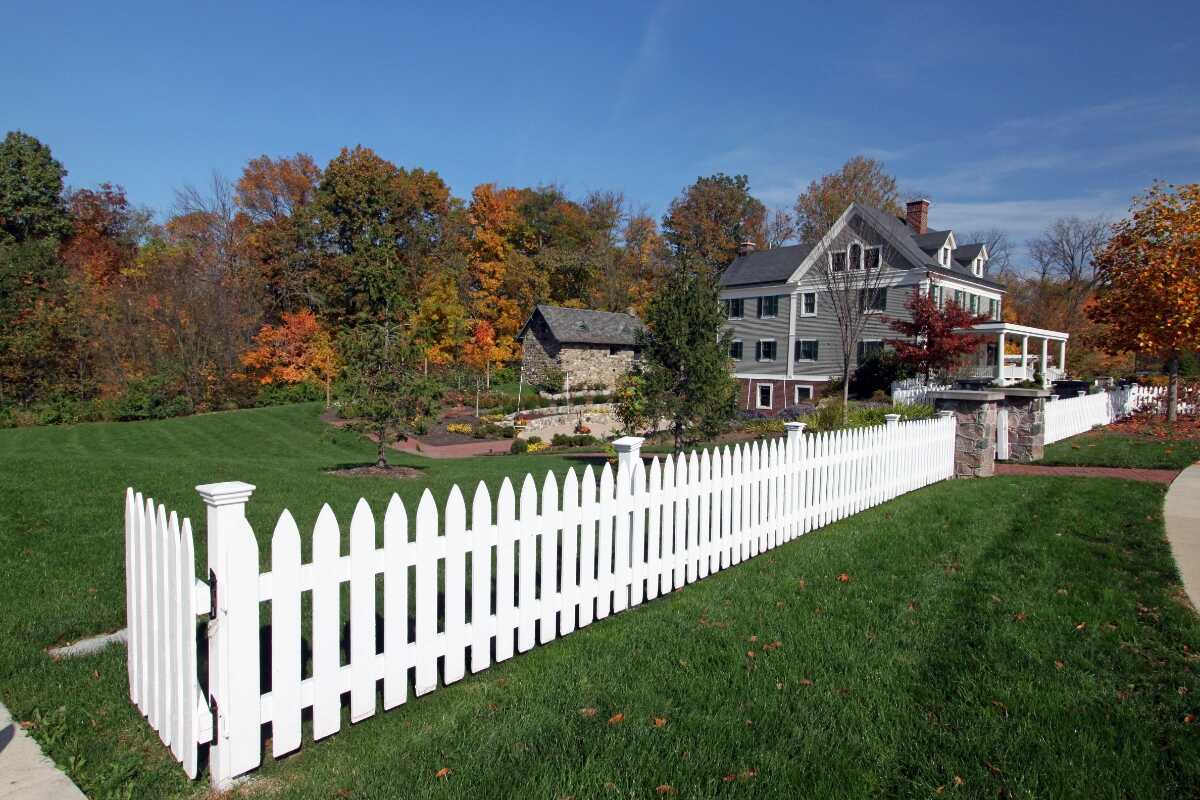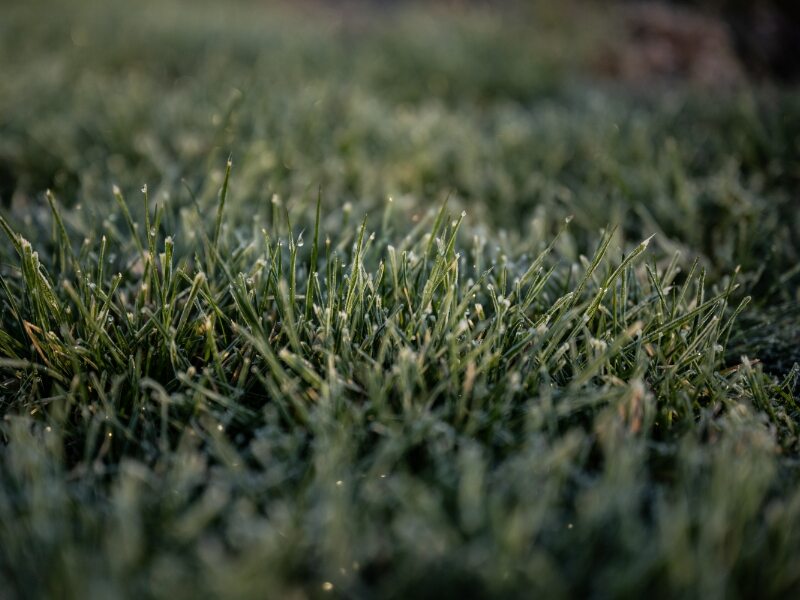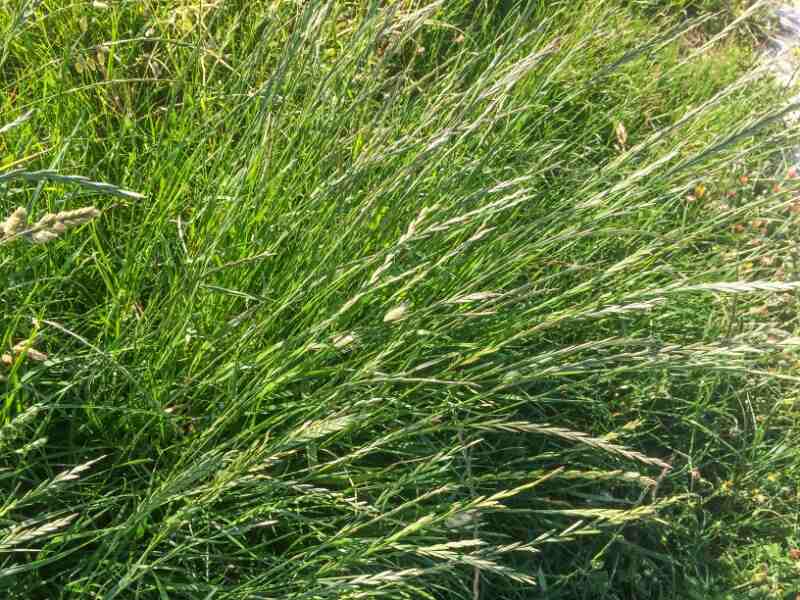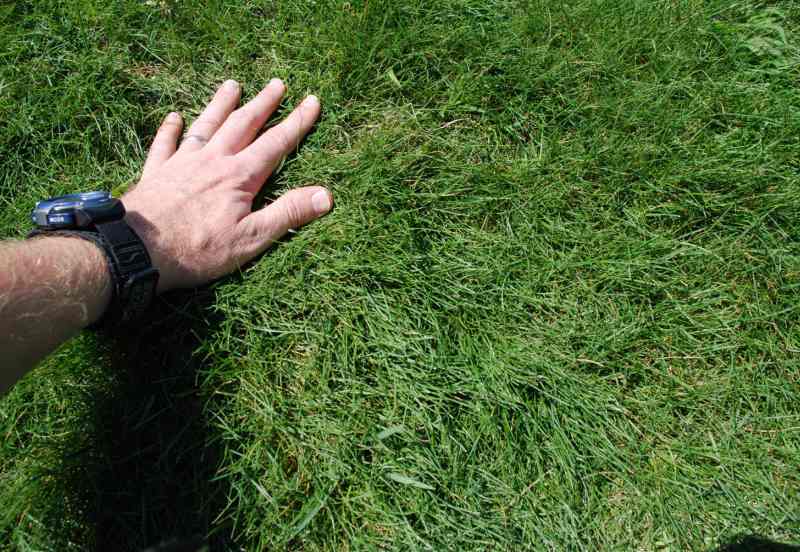
Knowing when to plant grass seed is the first step to a successful lawn, and in Indiana, the best time to plant grass seed is in late summer to early fall.
Why is this the best time to plant grass seed here in the Hoosier State? Well, this is the best time to plant cool-season grass types like Kentucky bluegrass and fescues, the most common types used for lawns across Indiana.
You can also plant grass seed in spring when the soil is warm after winter dormancy, but it’s not an ideal time because your cool-season turf will require frequent watering. Also, your grass also has to compete with summer annual weeds to survive.
In this article, learn more about when to plant the best grass seeds for Indiana lawns, including Kentucky bluegrass, tall fescue, perennial ryegrass, and fine fescues.
When to Plant Kentucky Bluegrass

Kentucky Bluegrass is the most common lawn grass type in Indiana, especially in the northern regions. Late summer through fall (at least 45 days before the first frost) is the best time to grow Kentucky bluegrass in Indiana. Plant the grass seed from late August to early September for the best root development.
The optimal soil temperature for bluegrass seed germination is 50 to 65 degrees Fahrenheit, and the seedlings thrive in daytime air temperatures ranging from 60 to 75 degrees. In the fall, lower temperatures and continuous moisture due to rainfall produce ideal circumstances for Kentucky bluegrass seed germination.
Avoid planting Kentucky bluegrass in spring. Here’s why: Because of its slow germination when the seeds take root, summer arrives before the new grass can be established, and the summer heat is far from ideal for the optimal growth of Kentucky bluegrass seedlings.
When to Plant Tall Fescue
Tall fescue is a versatile grass that can flourish in varying Indiana climates. Tall fescue is well-known for its drought resistance and adaptation to various soil conditions.
Tall fescue is best planted later in the summer through early fall or late winter to early spring in the northern regions, where summer temperatures are slightly more relaxed. The soil temperature should range between 50 to 65 degrees during planting for better root development.
Pro Tip: No matter what type of grass is growing in your yard, overseed your Indiana lawn with bunch-type tall fescue at least once a year in fall or early spring to improve your lawn’s shade tolerance and disease resistance.
When to Plant Perennial Ryegrass

Plant perennial ryegrass in Indiana from late summer to early fall (often from mid-August to September) or late winter to early spring. These times of year are excellent for establishing a fresh lawn with perennial ryegrass.
As it might take just five days for seeds to germinate, perennial ryegrass is probably your best bet if you want to plant in spring. Because perennial ryegrass grass can establish itself so quickly, it can withstand summer heat better than other cool-season grasses.
When you plant perennial ryegrass seeds, the soil temperature should be between 50 and 65 degrees, and the air temperature should range between 60 to 75 degrees..
Perennial ryegrass seeds may not withstand our hot and dry Indiana summers if they don’t have time to establish first. What this means: Avoid planting perennial ryegrass seeds when the temperature rises above 75 degrees and wait for the temperature to cool down again in fall.
When to Plant Fine Fescues

Like tall fescue, the best time to plant fine fescues is late summer to early fall. Why? The soil is warm after the scorching summer, and your lawn is ready to develop new roots.
Early spring is the second best time to seed your Indiana lawn with fine fescue because the soil temperature is suitable for germination. But remember, it is a challenging period because your grass has to compete with springtime weeds. Therefore, plant fine fescue grass seeds in early fall for the best-looking lawn.
Other Things to Know About Planting Grass Seed in Indiana
Planting grass seed in Indiana is the first step toward having a beautiful, green lawn. However, it’s not as simple as putting some grass seeds in the ground. To help you grow a vibrant lawn, here are some things you might need to know.
Select the Best Grass for Indiana
First and foremost, choose the best grass according to your location. Indiana has a somewhat inconsistent climate. Summers are hot, humid, and short, while winters are cold and harsh. So, choose cool-season grasses instead of warm-season grasses because only cool-season grasses can thrive through Indiana’s cold weather.
On the other hand, if you live in Southern Indiana, around Bloomington, New Albany, or Evansville, you might be able to grow Zoysia, a warm-season grass type, successfully. Keep in mind that your lawn will start to turn brown earlier in the fall than your neighbors’.
Timing Is Key
When it comes to planting grass seeds, timing is essential. In Indiana, plant grass seeds in the fall. Typically, late August to early October is the best time. The explanation is simple: Cooler temperatures and rainfall create the best conditions for your grass to grow. Plus, you’ll have a good start on your grass before it enters winter dormancy.
When NOT to plant grass seed in Indiana: If you plant the seeds in summer or in freezing winter, your grass probably won’t grow because of unfavorable temperatures, and planting at this time would be a waste of time and money.
Prepare the Soil
Before you can plant grass seeds, you have to set the stage, or in this case, the soil. Begin by removing any debris, rocks, or weeds from the area. Think of it as providing a blank canvas for your grass to grow on.
Aerate your Indiana lawn if the soil is compacted, as this will increase air and water penetration for a healthy root system. Seeds can also germinate more quickly because of the holes in the soil left behind by aeration. The timing works out, too, because fall is also the best time to aerate your lawn in Indiana.
Sow the Seeds
When it comes time to plant your grass seeds, don’t just toss them on the ground and hope for the best. For equal distribution, use a broadcast spreader or a hand spreader. After dispersing your grass seeds, lightly rake the area for optimal seed-to-soil contact. This is an essential step for seed germination.
Water Wisely
To germinate and flourish, your newly planted grass seeds require regular watering. So, immediately after planting, water the area carefully. During the germination period, keep the soil continually moist. This entails watering every day, but be careful not to overwater. Too much water might cause problems such as diseases and washed-out seeds.
Be Patient
It takes time to grow a nice lawn. Grass seedlings will appear in a few weeks, but it may take months for your grass to mature into a thick carpet. So, be patient and resist the impulse to walk on the freshly seeded area until the grass has grown in. Obviously, prevent children and pets from running around on the grass until it matures.
FAQ About Planting Grass Seed in Indiana
How much does it cost to plant grass seeds in Indiana?
The cost of planting grass seeds varies based on factors such as the grass type, the size of your yard, and the materials required. If you decide to take on the task yourself, you can expect to spend approximately $0.01 to $0.04 per square foot for the grass seed and an additional $15 to $700 for a spreader, depending on type and quality.
If, however, you choose to hire an Indiana lawn care pro, the cost of seeding a standard-sized lawn typically falls within the range of $680 to $1,815.
How can I prepare my Indiana lawn for the winter season?
Raking leaves, providing a winter fertilizer, and aerating the soil are all part of winterizing your lawn. Taking these steps will help protect your lawn throughout the cold Indiana winter.
However, if you plant your new grass seeds too close to the first frost of the year, they might not be strong enough yet to withstand winter temperatures, even if you do everything you can to prepare them.
Can you plant grass seed in Indiana during the winter?
Planting grass seed during the winter is generally not recommended in Indiana due to the cold and frozen soil conditions. The ideal time for planting grass is early fall, late summer, and, to a lesser extent, spring, as these times provide the most favorable conditions for successful germination and establishment.
When can you fertilize after planting grass seed?
You can fertilize new grass seeds immediately after planting them if you use a well-balanced starter fertilizer designed to foster new grass growth. After the first application of starter fertilizer, you should fertilize your lawn on a regular schedule. The right times of year to fertilize the lawn in Indiana are in spring, early fall, and late fall.
Did you know? You can now book lawn fertilization services directly through LawnStarter.
Hire a LawnStarter Lawn Care Pro in Indiana
No matter which type of grass you opt for in Indiana, getting your lawn off to the right start begins with choosing the right time to plant. But that’s just the beginning. After your new lawn has established itself, it requires year-round care, including consistent mowing, proper watering, timely fertilization, and other essential maintenance.
Does this all sound like too much? Don’t worry.
Hire one of LawnStarter’s lawn care in Indiana. Whether you live in Indianapolis, Evansville, Fort Wayne, South Bend, or anywhere else in the Hoosier State, our pros will help you grow a lush, green lawn.
Main Photo Credit: imagindiana / Canva Pro / License